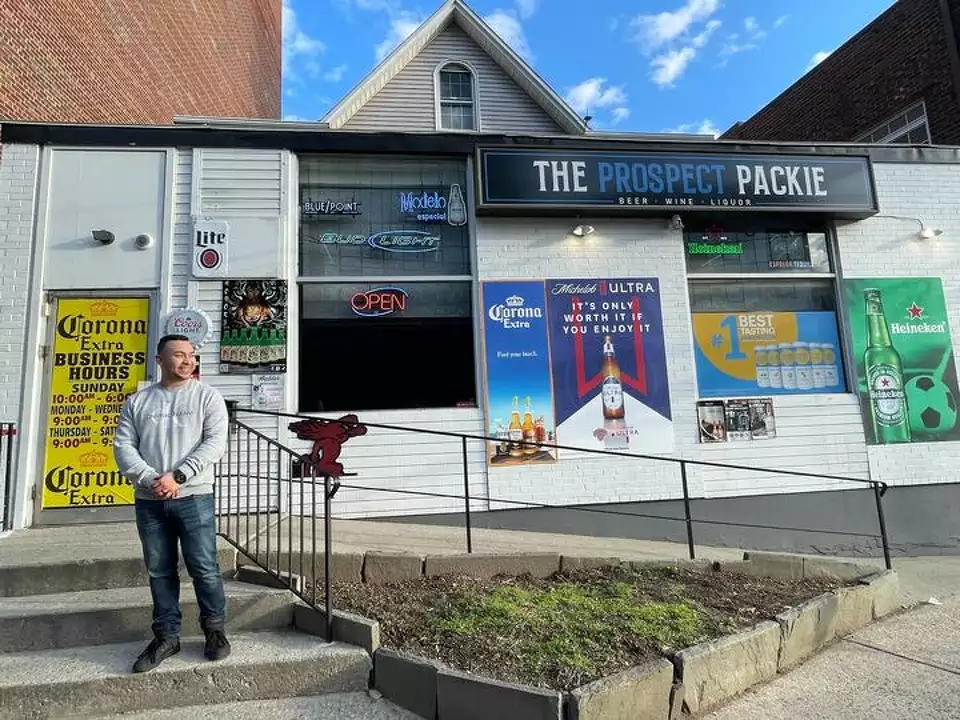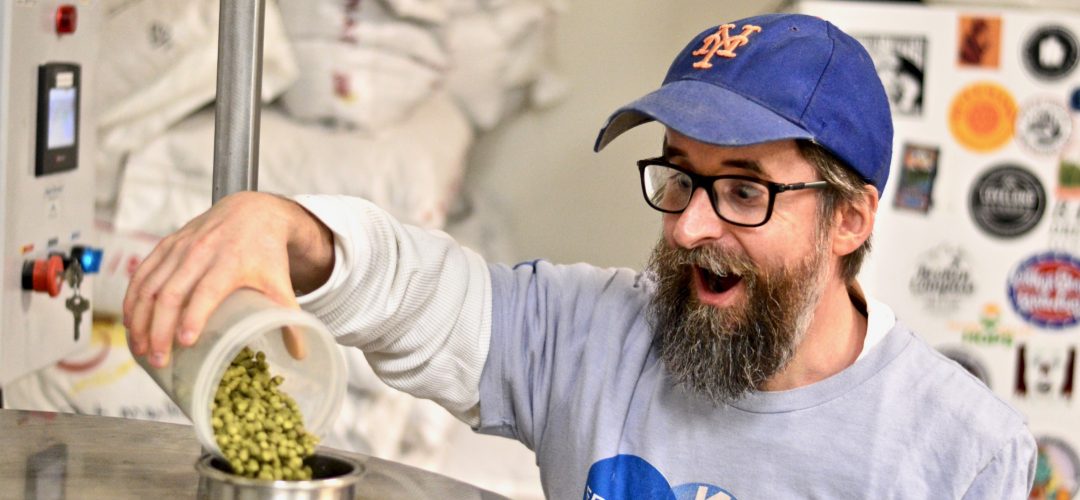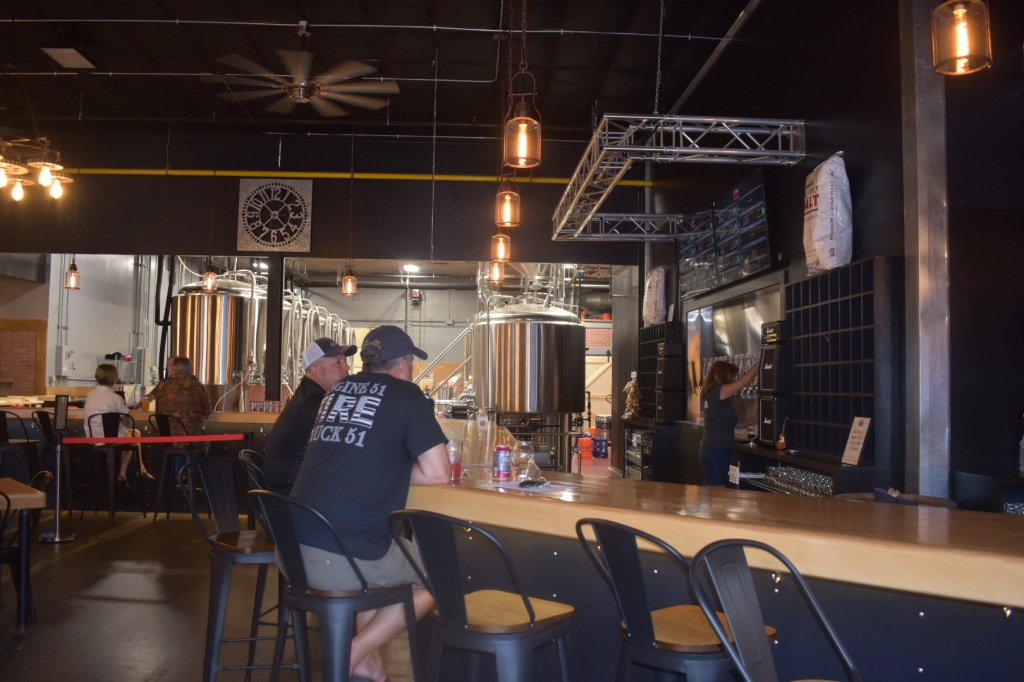Crab Claw Ale by Old Dominion Brewing - Like a sea captain's antidote to crustacean infestation.
Oberon Ale by Bell's Brewery - Like the aunt you thought was bringing cake but only brought the plate.
Red Fish by Flying Fish Brewing - Like a school of snappers spawning in your throat.
Schöfferhofer Grapefruit by Binding Brauerei - Like that Indiana Jones boulder falling off a truck onto your Vespa.
Narragansett Lager by Narragansett Brewing - Like the kitten you didn't know your guest had hiding in your shoe.
Schönramer Gold by Private Landbrauerei Schönram - Like Bavarian lollipop debris in a honey river.
McSorley's Old Ale House Light Beer by McSorley's Old Ale House - Like rainwater spilled from a pre-Civil War-era cistern.
All Day IPA (Session Ale) by Founders Brewing - Like a bucketful of flowers thrown by a part time teetotaller.
Gandhi-Bot by New England Brewing - Like living in a delicious world of civil disobedience and flower humanoids.
Conntucky Lightnin' Ale by Two Roads Brewing - Like a lumberjack wearing a flag that says "Don't tread on fleas."
The Crisp by Sixpoint Brewery - Like entering a door marked "gentle slap in face" and and receiving what's advertised.
Whiting St. by Relic Brewing Co. - Like a refreshing trip to pre-Prohibition/post-Inhibition 'Merrca.
Time Traveller Shandy by The Traveller Beer - Like a seeded red fruit stripped of its seed merit badge.
Yang by Evil Twin Brewing - Like dancing on the head of a pin, then the angel loses her grip during the dip.
Yin by Evil Twin Brewing - Like getting between Mike Tyson's fist and his other fist.
Narragansett Summer Ale by Narragansett Brewing - Like a sun-dappled orange peel on Heaven Avenue.
Czech Style Pilsner by Berkshire Brewing - Like the crisp, sweet bite of the waterfall.
Igor's Dream by Two Roads Brewing - Like Natasha's go-to mashed potato sedative.
Leffe Blonde by Abbaye de Leffe - Like that palindrome: toosweeteewsoot.
Wayan by Birra Baladin - Like an underpuckered kiss from Aunt Bella.
Jersey Summer Breakfast Ale by Cricket Hill Brewing - Like a juicy bit of gossip about what Bon Jovi ate this morning.
Samuel Adams Summer Ale by Boston Beer - Like the shallow end of the lemonade pool.
Dubbel by Allagash Brewing - Like the abridged version of _Great Expectations_.
Weihenstephaner Hefeweissbier by Bayerische Staatsbrauerei Weihenstephan - Like a schmeck of sunshine on a nicht so gut day.
Blindfold by Sierra Nevada Brewing - Like a ninja attacking a Starbucks and sharing the spoils.
White by Allagash Brewing - Like hanging out with a suddenly rich friend who turns out to still be cool.
Dale's Pale Ale by Oskar Blues Brewery - Like being on a sailboat. Because I am!
Tenacious Traveler Shandy by Traveler Beer Co. - Like a lemon pop, ginger hop shakedown breakdown.
Honeyspot Road White IPA by Two Roads Brewing - Like summer in a lobster cage.
Samuel Adams Summer Ale by Boston Beer - Like inviting the pool guy named Lemonisto over in March just to hurry up the season.
Hizzoner Maibock by Two Roads Brewing - Like a smooth freeway that merges onto the cinnaminterstate.
Samuel Adams Blueberry Hill Lager by Boston Beer - Like Fats Domino Sugar Hill Gang singing sweetly.
Samuel Adams Porch Rocker by Boston Beer - Like if life gave you lemons and you made lemon fizz.
Samuel Adams Little White Rye by Boston Beer - Like looking for the illusion that's not there and not seeing it.
Blueberry Ale by Blue Point Brewing - Like Veruca Salt square dancing in your backyard alone.
Porcine Unidragon by Clown Shoes - Like a well-fed, tuxedoed licorice farmer on your chest.
Bass Pale Ale by Bass Brewers - Like an old friend who gets a little more tired each time.
Porterhouse Oyster Stout by Porterhouse Brewing Co. - Like a wave of pearls on the Irish Sea, if there is an Irish Sea.
Ommegang Witte by Brewery Ommegang - Like a gentle caress from a sunflower in bloom.
Misty Mountain IPA by Back East Brewing - Like a tweak on the nose and a sprinkle of fairy dust on the back of your tongue.
Toasted Lager by Blue Point Brewing - Like the crusty end of lollypop toast.
Black Hop IPA by Shebeen Brewing - Like a towel rubbing your noggin after a stroll through the garden dew.
Liberator Doppelbock by Thomas Hooker Brewing - Like a chocolate blanket on a cool night in Mellowtown.
Brother Thelonious by North Coast Brewing - A plink plink plonk a rebop dig it baby kind of scene, cat.
Shed Mountain Ale by Otter Creek Brewing - Like a cocoa avalanche that pins you to a chocolate factory.
Naughty Goose by Goose Island - Like a humane mousetrap of walnut intimacy.
Summertime by Goose Island - Like a Slip n' Slide into Sunshine City.
Munich-Style Golden Lager by Thomas Hooker Brewing - Like a buttery biscuit eaten in the rain.
White by Allagash Brewing - Like the amusement park in heaven.
Grand Circus IPA by Atwater Brewery - Like the clowns that live in the attic fit 20 buckets of oranges in a Prius.
Session Premium Lager by Full Sail Brewing - Like an aspirin when you're blindfolded and expect a Valium.
Odyssey by Allagash Brewing - Like a lollypop dredged through a square yard of sugar.
Dark Hollow by Blue Mountain Brewery - Like soupy sludge: paradise edition.
Heady Topper by The Alchemist - Like a Triple Crown winner who accidentally runs through your backyard.
Brooklyn Pilsner by Brooklyn Brewery - Like a German tourist who stumbles upon Williamsburg.
668 The Neighbor of the Beast by New England Brewing - Like being invited to a kegger and finding out it's a ball.
Namaste by Dogfish Head Craft Brewery - Like a bumpy ride that ends at the corner of Hmmm and Nice.
Ben Harris by Redhook Ale Brewery - Like looking up the popular guy from high school and finding out he's a jerk.
Worker's Comp Saison by Two Roads Brewing - Like a flash of light coming from the edge of the dark pineapple grove.
Bengali Tiger by Sixpoint Brewery - Like a double play thrown from Hop to Lemon to Gardenmouth.
Cabin Fever by Berkshire Brewing - Like a sugar bath with a toffee rubber ducky.
Singletrack Copper Ale by Boulder Beer - Like a red balloon hiding in a pile of dirty socks.
Enjoy By 04.01.13 IPA by Stone Brewing - Like a spring shower in very late March. (Finally!!!)
There Will Be Black by Brooklyn Brewery - Like a begonia hiding under an oil slick.
Dean's Beans Coffeehouse Porter by Berkshire Brewing - Like a hot chocolate mustache on a Doberman shepherd.
Guinness Draught by Guinness - Like an old hat that starts to slip off.
Mean Old Tom by Maine Beer - Like a charcoal suit that fits best on Wednesday.
Stone Ruination IPA by Stone Brewing - Like a full body slap from a large, pretty hand.
Ol'Factory Pilsner by Two Roads Brewing - Like a rivulet of nice that longs to be the ocean of wow.
Porter by Back East Brewing - Like a mug of cold cocoa with a chalk straw.
Spinster XPA by Thomas Hooker Brewing (on cask) - Like a sweet old lady who sits in church wearing spiked heels.
Bright Ale by Half Full Brewery - Like a boomerang to the palate.
Dean's Beans Coffeehouse Porter by Berkshire Brewing - Like a mudbath mustache callabash meeting with corporate.
Transatlantic Belgian IPA by Relic Brewing - Like a tropical rollercoaster that gets set ablaze.
Narragansett Porter by Narragansett Brewing - Like a sudden elevator drop into a bathtub made of licorice.
Concord Grape Saison by Shebeen Brewing - Like Miss New York's twisted mouth in purple lipstick.
Cannoli Beer by Shebeen Brewing - Like playing Candyland with chocolate gold coins.
Chocolate Indulgence by Brewery Ommegang - Like Valentine's chocolate in June.
Carpenter's Ale by City Steam Brewery - Like a well-constructed lean-to at the swamp's edge. (On cask.)
Hop Meadow IPA by Thomas Hooker Brewing - Like a mouth full of tiny siesta-taking bees. (On cask.)
Ruthless Rye IPA (2013) by Sierra Nevada Brewing - Like a scratch on that itch on the back of your neck.
Noble Rot by Dogfish Head Craft Brewery - Like an off-color joke whispered by a dirty angel.
Imperial Stout by Back East Brewing - Like a donkey that kicks over the torch that burns down the village. (On cask.)
Imperial Cascadian Ale by Half Full Brewery - Like a high note sung by a dirty choir.
Directors' Cut by Harpoon Brewery - Like an unearthed scene from "Weird Science" where Bill Paxton sips chocolate milk through a garden hose.
Blackheart by Relic Brewing - Like a musical version of "Backdraft," starring C. Thomas Howell.
Bourbon County Brand Stout by Goose Island Beer - Like a licorice pea coat filled with tiny barrels of fudge.
La Fin Du Monde by Unibroue - Like a hot air balloon ride to Ontario with a Mayan calendar.
Diesel by Sixpoint Brewery - Like a one-armed tightrope walker with an itchy kneecap.
Dirty Penny (Aged On Vanilla Beans & Coffee) by Olde Burnside Brewing - Like a coffee ground sandwich made with burnt raisin toast. (On cask.)
Honeyspot Road White IPA by Two Roads Brewing - Like a feather that satisfied your uncle and now your aunt's intrigued.
Naughty Nurse by City Steam Brewery - Like a sponge bath in spring while listening to the Andrews Sisters.
Connecticut Pale Ale by Southport Brewing - Like a ride down a river lined with crocodiles with poetry degrees
Cabin Fever by Berkshire Brewing - Like an effervescent pixie flitting about in the kitchen making waffles.
Careless Love by City Steam Brewery - Like a road slick with sweet sweat and sweeter beef.
Naughty Goose by Goose Island Beer Co. - Like a tender hug from a man who loiters around the chocolate factory.
Samuel Adams Alpine Spring by Boston Beer Co. - Like sucking down a ginger ale left after a party that ended June 12, 2005.
Pig's Ear Brown Ale by Woodstock Inn Brewery - Like a roll in the candied sty.
Oatmeal Stout by Samuel Smith Old Brewery - Like a daydream wrapped in a mink coat rolled in oats.
Indie Brown Ale by Blind Willy Brewing - Like a beer I brewed six months ago. Because it is.
Guinness Draught /Harp Lager (Black and Tan) by Guinness - Like leather and lace, all up in your face.
Imperial Stout by Founders Brewing Co. - Like a warn hug from Saint Sweetbottom.
1687 Brown Ale by Charter Oak Brewing - Like an awkward high-five with the coffee vendor.
Harpoon IPA by Harpoon Brewery - Like a good neighbor, Harpoon is there...
Sweet Action by Sixpoint Brewery - Like a rare errant arrow that strikes the caramel buffalo.
Dirty Bastard by Founders Brewing - Like a catcher's mitt bragging about going to the Toffee All-Star Game.
POM Wheat by Hillside Brewing - Like a delicate dance with a hippo named Fruitface.
Gerry Dog Stout by Big Elm - Like sliding through an oak barrel slip slide and splinter.
Gold Spike Ale by Berkshire Brewing - Like enjoying a breeze through a small window on a hazy day.
Delirium Nocturnum by Brouwerij Huyghe - Like walking sideways through a crowd of jumping pink revelers.






